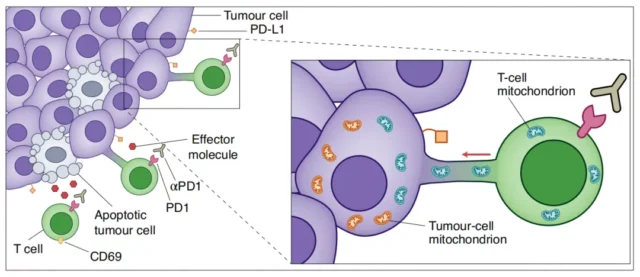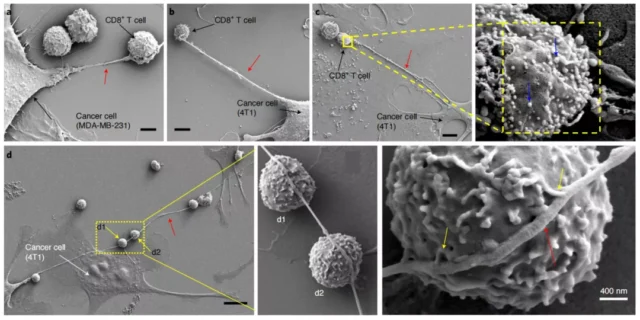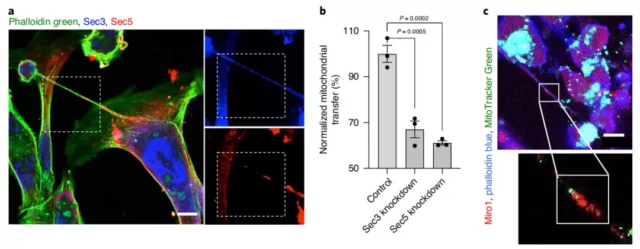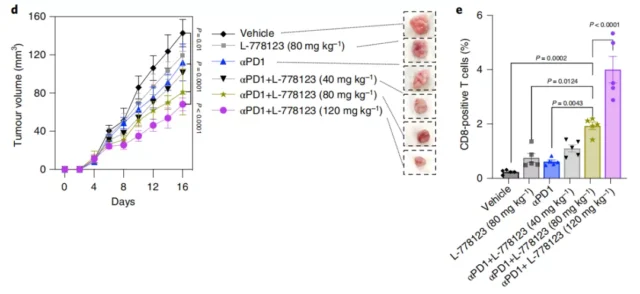Cancer cells steal mitochondria of T cells and realized immune escape
- Normal Liver Cells Found to Promote Cancer Metastasis to the Liver
- Nearly 80% Complete Remission: Breakthrough in ADC Anti-Tumor Treatment
- Vaccination Against Common Diseases May Prevent Dementia!
- New Alzheimer’s Disease (AD) Diagnosis and Staging Criteria
- Breakthrough in Alzheimer’s Disease: New Nasal Spray Halts Cognitive Decline by Targeting Toxic Protein
- Can the Tap Water at the Paris Olympics be Drunk Directly?
Mitochondria stole Cancer cells steal mitochondria of T cells and realized immune escape
- Should China be held legally responsible for the US’s $18 trillion COVID losses?
- CT Radiation Exposure Linked to Blood Cancer in Children and Adolescents
- FDA has mandated a top-level black box warning for all marketed CAR-T therapies
- Can people with high blood pressure eat peanuts?
- What is the difference between dopamine and dobutamine?
- How long can the patient live after heart stent surgery?
Cancer cells steal mitochondria of T cells and realized immune escape.
On November 18, 2021, researchers from Harvard Medical School in the United States published a research paper titled Intercellular nanotubes mediate mitochondrial trafficking between cancer and immune cells in the journal Nature Nanotechnology .
This study provides evidence that cancer cells cleverly use the tactical strategy to steal the mitochondria (cell energy factories) of T cells through nanotubes .
While strengthening themselves, they also weaken the activity of immune cells and thus outsmart immunity. System to achieve immune escape.

With the development of life sciences, scientists have deepened their understanding of immunity, metabolism and tumors.
Previously, a large number of studies have emphasized that mitochondria are vital to the metabolism and activation of immune cells.
For example, increasing mitochondrial biomass and spare breathing capacity have been shown to enhance the persistence of T cells and provide the necessary bioenergy advantage to eradicate cancer cells and prevent potential recurrence.
Hard power is important when the two armies are facing each other, but strategizing is also the key to victory.
Faced with the suppression of the firepower of the immune system, will cancer cells evolve a mechanism to weaken them and then outwit the immune system?
In this study, the research team first noticed mitochondrial transfer, an easily overlooked intercellular communication phenomenon.
They established a simple co-culture system in which immune cells are labeled with fluorescent dyes and selectively aggregate in mitochondria.
Based on this, the research team was able to observe contact-dependent dye transfer and infer the movement of immune cell mitochondria.
 Fluorescent dye traces show the contact between tumor cells and immune cells
Fluorescent dye traces show the contact between tumor cells and immune cells
They found that when immune cells and tumor cells are co-cultured, the mitochondria of immune cells transfer to tumor cells .
In order to rule out the false positive results caused by the leakage of non-specific free dyes, the transfer of the fluorescently labeled mitochondrial protein, Dendra2 green-labeled cytochrome c oxidase subunit 8 was also discovered.
The combination of these different tracing methods confirms that the phenomenon seen is real, that is, tumor cells will “steal” the mitochondria of immune cells in some way .
 Tumor cells hijack the mitochondria of immune cells through nanotubes
Tumor cells hijack the mitochondria of immune cells through nanotubes
Therefore, the research team further explored the ways in which tumor cells “drained from the bottom” of immune cells.
Mitochondrial transfer between cells involves multiple mechanisms, including gap junctions, nanotubes, cell fusion, and extracellular vesicles.
It was observed by electron microscopy that there were nanotube-like structures between tumor cells and immune cells , and the co-localization of fluorescently labeled mitochondria and known mitochondrial transporters at the nanotube sites.

Under the electron microscope, cancer cells and immune cells are connected by physical nanotubes
Then, the research team targeted to knock out the genes for nanotube formation (Sec3, Sec5) and mitochondrial transport (Miro1) , and the phenomenon of mitochondrial transfer disappeared. Based on these evidences, the researchers clearly established a causal link, that is, tumor cells use nanotubes to “steal” the mitochondria of immune cells .
More importantly, the research team also pointed out that this mitochondrial hijacking phenomenon does not only occur in the in vitro co-culture system, but also occurs in the body, thus emphasizing its clinical relevance.

After inhibiting the formation of nanotubes (knockout Sec3, Sec5, Miro1 genes), tumor cells can no longer steal the mitochondria of immune cells
Now that the tactical strategies of tumor cells have been discovered, how can we prevent them from “drawing from the bottom”?
In fact, before this, many studies have found some inhibitors that inhibit the formation of nanotubes, which can prevent this immune escape strategy of tumor cells.
The research team verified this theory in an adenocarcinoma model by using an anti-PD-1 antibody in combination with a nanotube inhibitor- L-778123 .
They found that at non-cytotoxic concentrations, L-778123 can effectively inhibit the formation of nanotubes.
Compared with treatment alone, L-778123 combined with PD-1 inhibitors significantly increased the activation and infiltration of T cells in tumors, leading to delayed tumor progression and prolonged survival time of tumor animal models.
 L-778123 combined with PD-1 inhibitors leads to delayed tumor progression and prolonged survival time of tumor-bearing animals
L-778123 combined with PD-1 inhibitors leads to delayed tumor progression and prolonged survival time of tumor-bearing animals
Although the systemic administration and non-specificity of L-778123 hinder clear conclusions about its mechanism of action, these findings clearly indicate the potential therapeutic value of the combination therapy.
The research team said that a more specific and targeted method can be used to deliver inhibitors directly to tumors in the body, thereby avoiding its side effects.
Image
Nanotube inhibitor L-778123 combined with PD-1 inhibitor can enhance the effect of anti-tumor treatment
All in all, this latest study shows that cancer cells can capture the mitochondria of immune cells through nanotube-mediated hijacking, thereby weakening the immune capacity of immune cells .
It’s like cancer cells have also learned the “Thirty-Six Strategies” and skillfully use “drawing from the bottom” to strengthen themselves and weaken their opponents, so as to achieve immune escape.
In follow-up studies, the research team also confirmed that the nanotube inhibitor L-778123 can be combined with PD-1 inhibitors to enhance the immune system’s ability to kill tumor cells, and may become a new anti-tumor treatment in the future.
Paper link:
https://www.nature.com/articles/s41565-021-01006-y
https://www.nature.com/articles/s41565-021-01000-4
Cancer cells steal mitochondria of T cells and realized immune escape
(source:internet, reference only)
Disclaimer of medicaltrend.org
Important Note: The information provided is for informational purposes only and should not be considered as medical advice.



